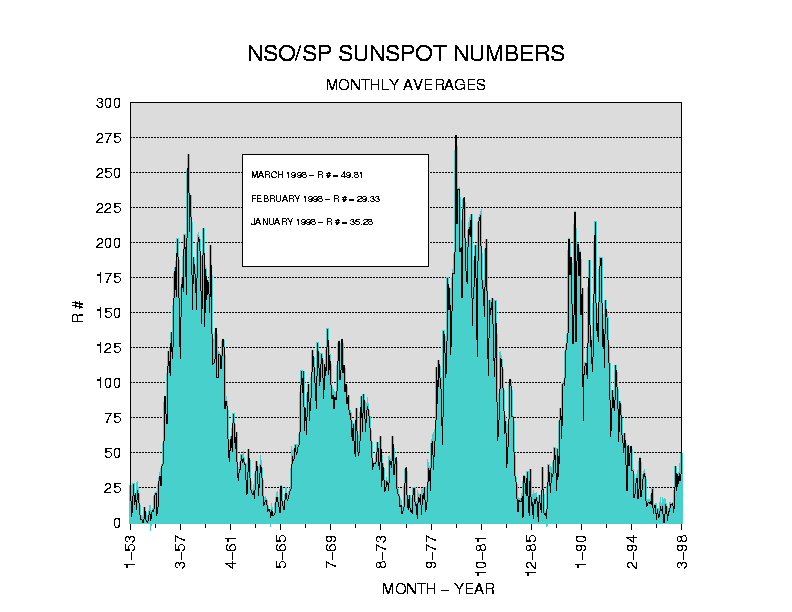
Figure 1
R# is equal to the average monthly sunspot numbers
We are presently coming out of a low period of sun spots
(NSO/SP means National Space Observatory/Sacremento Peak)
The understanding of the A and K indexes will become a very important issue when one begins serious HF operation. Without this knowledge, one will only know that the bands are "good" based upon actually getting on and attempting a contact. Furthermore, with a little pre-knowledge of the conditions, you will be able to determine if a schedule is going to work on this date or that, or whether you will be able to make the "trip" overseas for that rare DX that will be on the air. In otherwords, understanding how to interpret the indexes will allow you to reach your full contact potential (sounds pretty painful, but it's not). Next time you tune into WWV or WWVH at 18 minutes past the hour, you'll know what they are talking about.
Quite simply, the K index is also know as the Solar Flux (SF). Sun spots are cool points on the sun's surface. About every 11 years there is a sun spot maximum...that is, every 11 years there are usually more spots that at any other time (see figure 1). Similar to a sine wave, it oscillates between high (above 200 spots) to low (right around 60 spots), although it is not completely similar to a sine wave (because it rises faster than it fades off). Realize that these are the maximums and minimums. In any given 11 year cycle, the number does not have to go as high as 240+ or as low as 60.

Figure 1
R# is equal to the average monthly sunspot numbers
We are presently coming out of a low period of sun spots
(NSO/SP means National Space Observatory/Sacremento Peak)
The A index is the level of geomagnetic activity. Geomagnetic activity includes anything that upsets the magnetic field that surrounds the earth. Things that can disrupt this field include solar dust (which comes off of the sun during a solar flare) and other charged space dust. The A index can range from 0 up to 40. A lower number indicates that the geomagnetic field is less disturbed. The higher the A index climbs, the "louder" the noise on the bands becomes. Quite bands, therefore, correspond to low A indexes. Quiet bands allow weaker signals to come through more clearly, as there is less noise to interfere.
It should be relatively obvious that the ideal conditions occur when the K index (SF) is high and the A index is low. Another interesting phenomenon to note is that the sun rotates once every 28 days or so. This is interesting because you can predict that the conditions may be similar to the conditions right now. I say "may be similar" because the sunspots come and go...they may go away by the time the sun has rotated all the way so that we can see the "same" place again. With this basic knowledge, you will now be able to interpret the WWV transmissions in order to maximize your enjoyment from the hobby.
Last Modified: 4/10/98